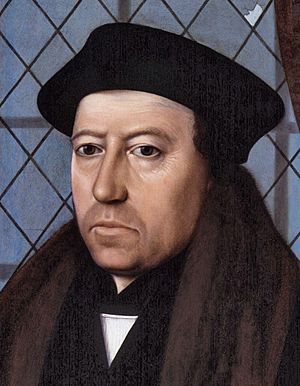Forty-two Articles facts for kids
The Forty-two Articles were a set of official rules for the Church of England in 1553. They were written by Archbishop Thomas Cranmer and published by King Edward VI's advisors, known as the privy council. These articles were a big step in changing the church to be more Protestant.
They helped the Church of England find its place among other Protestant groups. The articles disagreed with some ideas from groups like the Anabaptists and Zwinglians. However, they didn't fully follow the ideas of Calvinists or Lutherans.
Contents
How the Articles Came About

Before these articles, there were other church rules. These included the Ten Articles (1536) and the Bishops' Book (1537). Archbishop Thomas Cranmer wrote some articles in 1538. He hoped to unite the church with Lutherans at that time.
However, King Henry VIII instead made his own rules, called the Six Articles, in 1539. These rules were very strict. For example, married church leaders had to separate from their wives.
Changes Under King Edward VI
When King Henry VIII died, his son King Edward VI became king in 1547. The English Reformation (the period of big changes in the church) sped up again. The strict Six Articles were removed. This opened the way for new church rules that matched the Reformation's ideas.
It took six years for the Forty-two Articles to be released. This was because not everyone agreed on how much the church should change. Also, Cranmer hoped that all Christians could unite under new Reformation ideas. By 1551, it was clear this wouldn't happen quickly.
Writing and Approval
Cranmer started asking new church leaders to agree to certain rules by 1549. In 1551, he showed a draft of the articles to church leaders. The final Forty-two Articles were meant to be the official rules for the Church of England. They were similar to the Lutheran Augsburg Confession.
In 1551, the king's privy council told Cranmer to write the Articles of Religion. The next year, his draft was sent to some church leaders and then to the king's advisors. The process was slow because some people didn't fully support the Reformation.
However, the articles stayed mostly as Cranmer wrote them. He had help from two laymen, William Cecil and John Cheke. Even though the articles said they were agreed upon by church leaders in a meeting, it seems no such meeting actually happened.
The privy council received the articles from Cranmer in November 1552. On June 19, 1553, they ordered all church leaders to agree to them. Some people, like Hugh Weston, resisted signing them.
What the Articles Said
The Forty-two Articles covered many important beliefs. They explained what the Church of England believed about God, the Bible, and how people are saved.
Key Teachings
Many articles were written to disagree with some Roman Catholic teachings.
- Article 11 taught that people are made right with God by faith alone. This was different from the Roman Catholic teaching that both faith and good actions were needed.
- Articles 12 and 13 rejected ideas like "works of supererogation." This was the idea that people could do more good deeds than God required.
- Article 23 rejected beliefs about purgatory (a place of cleansing after death), indulgences (ways to reduce time in purgatory), and praying to saints.
- Article 26 said that church ceremonies (sacraments) don't automatically give grace.
- Article 29 rejected the idea of transubstantiation. This was the belief that the bread and wine in the Lord's Supper literally turn into the body and blood of Christ.
- Article 30 rejected the teaching that the Mass was a repeated sacrifice of Christ.
The articles also disagreed with some ideas from Anabaptist groups.
Predestination and Sacraments
The Forty-two Articles tried to find a middle ground on the idea of predestination (God choosing who will be saved). Article 17 talked about the comfort this belief could bring. The articles also showed some influence from Lutheran ideas.
Articles 29 and 30 were similar to Calvinist views on the Lord's Supper. They disagreed with the idea that Christ's body was everywhere or truly present in the sacrament.
What Happened Next
The Forty-two Articles were part of a bigger plan to make the Church of England more Protestant. This plan also included the First Book of Homilies (1547) and the Book of Common Prayer (1549 and 1552).
However, soon after the articles were announced in 1553, Queen Mary, who was Catholic, became queen. She stopped the use of these articles.
The Thirty-nine Articles
After the Protestant Queen Elizabeth I became queen in 1558, the articles were brought back. They were revised, especially the parts about the eucharist (Lord's Supper). These revised articles became known as the Thirty-nine Articles.
The Thirty-nine Articles are still part of the Book of Common Prayer today. They are important rules for the Church of England and the wider Anglican Communion. Their influence can also be seen in Methodism, through John Wesley's changes to them.
Images for kids
-
Thomas Cranmer, who wrote the Forty-two Articles.


